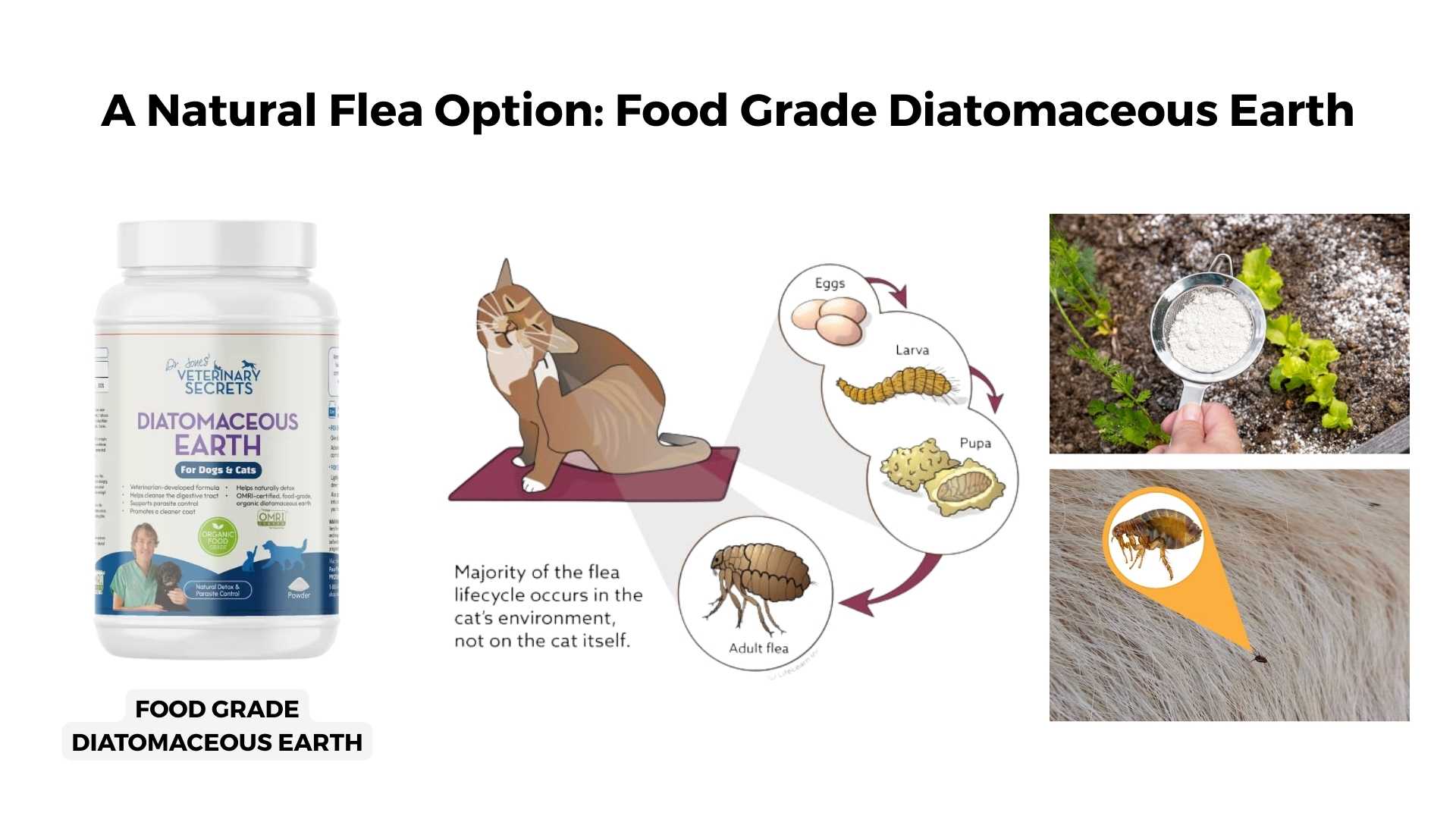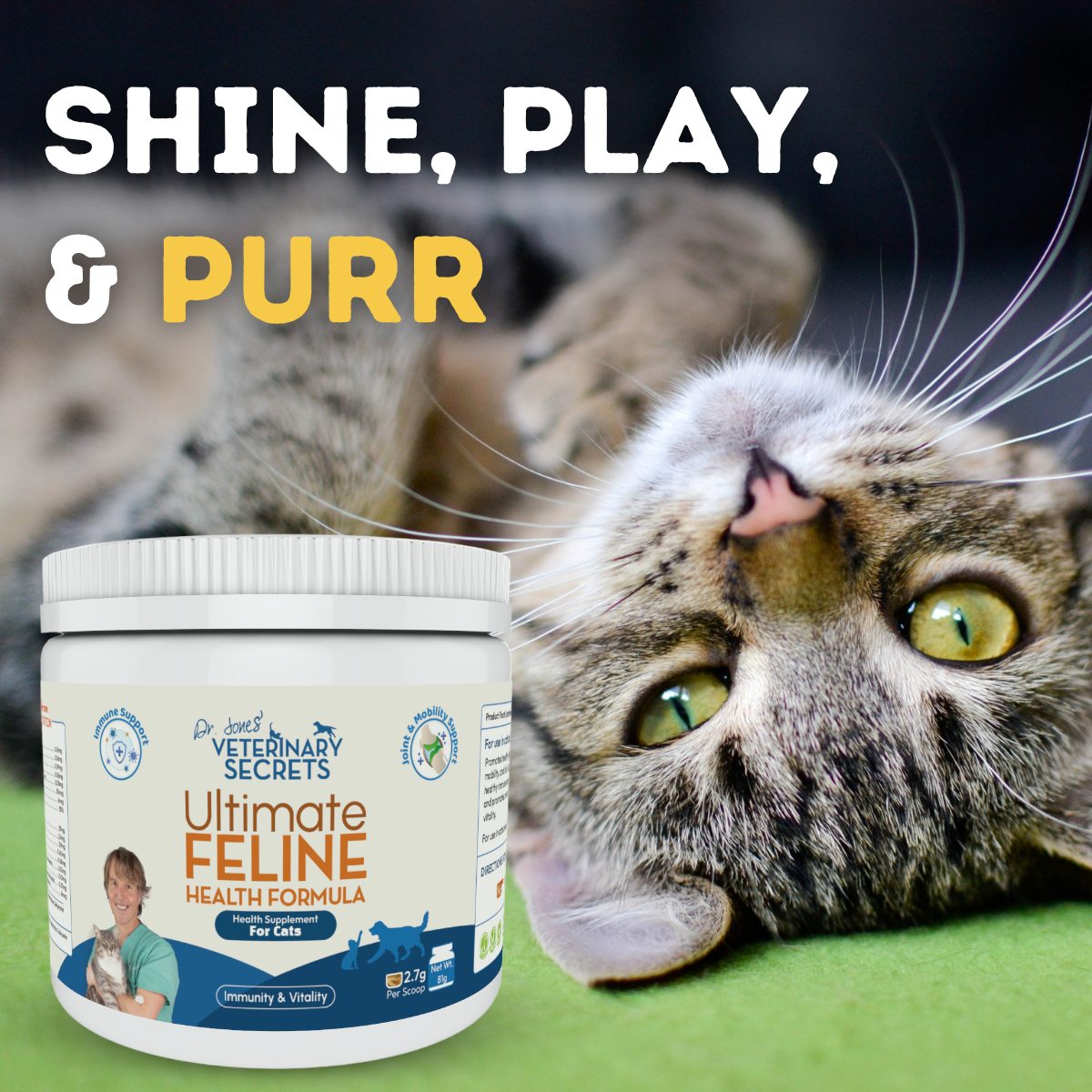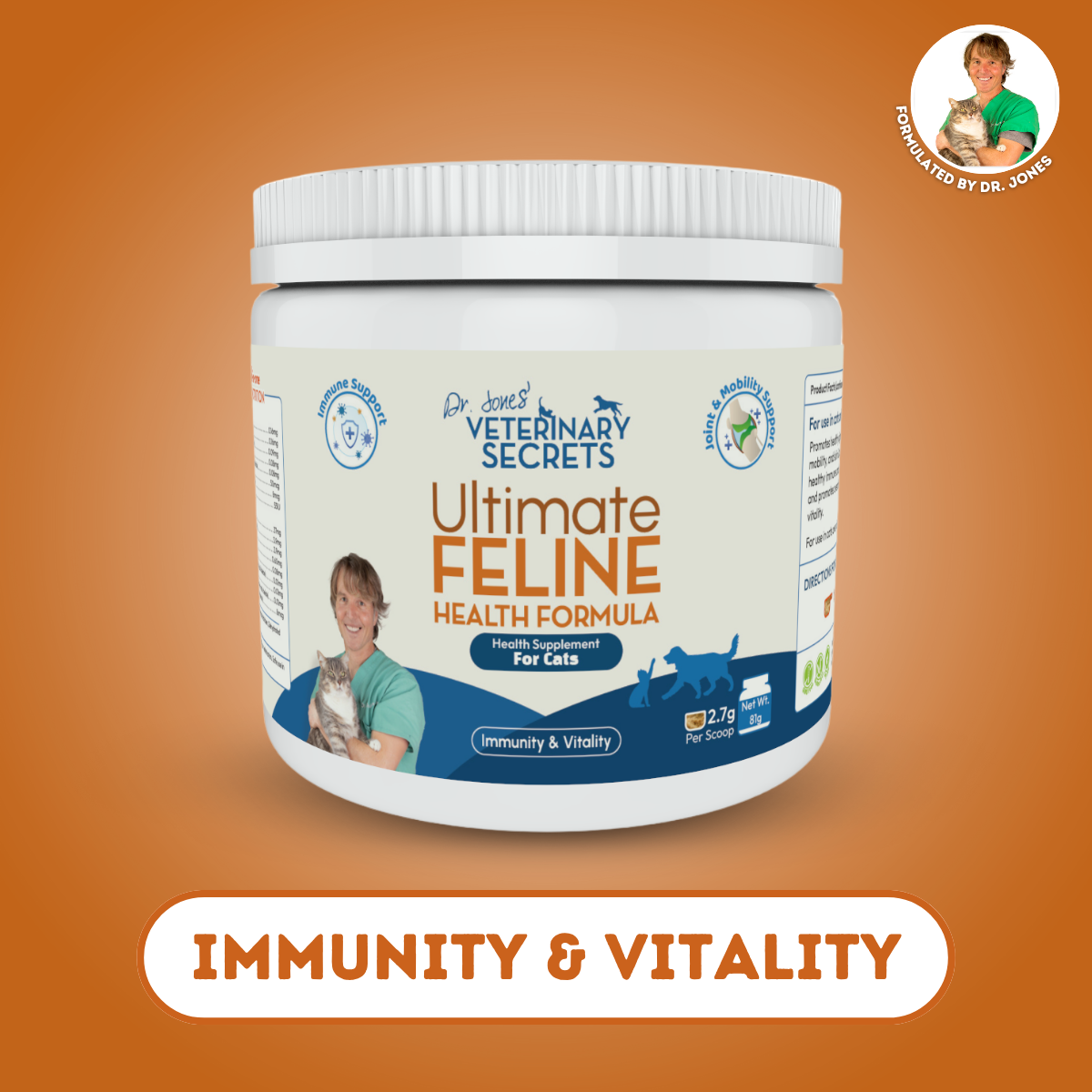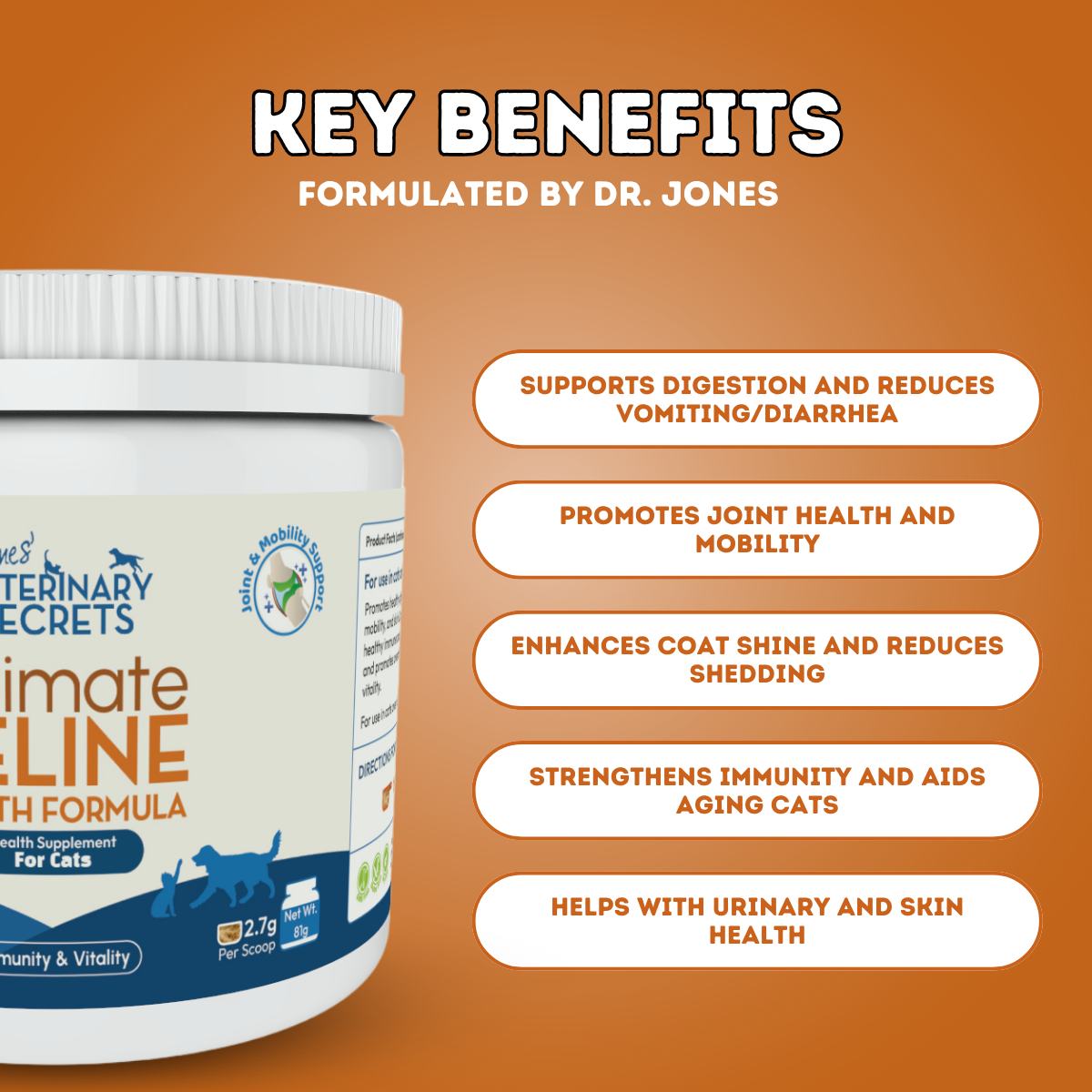Cat Licking Too Much? The Real Reasons and How to Help Naturally
![]()
Why Your Cat Might Be Overgrooming And How To Help
Do you have a cat that seems to be licking and grooming all the time?
My own cat, Cassian, is a bit of an overgroomer, so I know how concerning it can be when you start to see bald spots, red skin, or constant licking and chewing.
In this article, I want to walk you through the most common reasons cats overgroom and, more importantly, what you can do at home to help your cat feel better.
If you like learning about natural pet health and wellness, you can also click to subscribe to Veterinary Secrets and join my upcoming free webinar on natural anti inflammatories and pain control for dogs and cats with arthritis.
Dr. Jones’ Ultimate Feline Health Formula

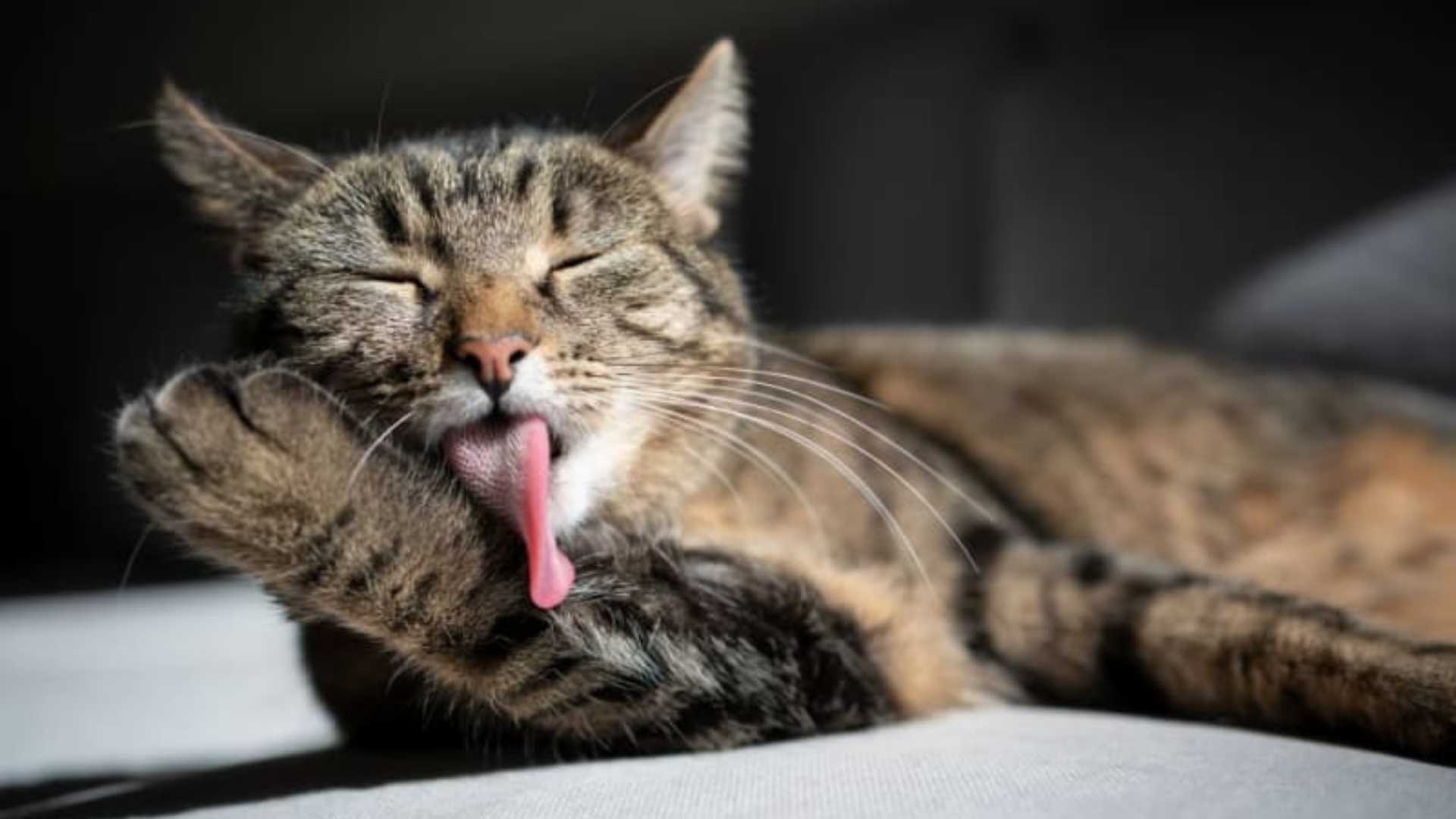
Is Grooming Normal For Cats?
Yes. Grooming is 100 percent normal cat behavior and it offers many health benefits.
Cats are naturally clean animals. They do not like anything on their skin, so they constantly tidy and smooth their coats. It is estimated that cats spend up to half of their awake time grooming.
That is one of the big reasons we see fewer skin problems in cats than in dogs. They are always cleaning themselves.

It becomes a problem when:
-
Your cat seems to groom almost all the time
-
You start to notice patches of hair loss
-
You see red, irritated skin on the tail base, belly, groin or legs
That crosses the line into overgrooming, and it is a sign something else is going on.
Reason 1: Fleas And External Parasites
The first thing I always look for in an overgrooming cat is external parasites, especially fleas.
Even a few fleas can make your cat miserable. Many cats will groom and chew to try to relieve the itch, which can lead to hair loss and skin irritation.
How To Check Your Cat For Fleas
Get a simple plastic flea comb and go over your cat’s fur slowly, especially along the back, tail base and belly.
You may see:
-
Adult fleas
-
Flea dirt (flea poop), which looks like tiny black specks
If you wipe the specks on a damp white tissue, flea dirt will often smear reddish brown, since it is digested blood.
A Natural Flea Option: Food Grade Diatomaceous Earth
One of the safest topical options I suggest is food grade diatomaceous earth.
It comes from the microscopic exoskeletons of ancient sea creatures and looks a bit like flour.
You can:
-
Put it into an empty spice shaker
-
Sprinkle a light dusting over your cat’s coat
-
Use a flea comb to spread it evenly through the fur
Important notes:
-
Only use food grade diatomaceous earth
-
It can dry the skin, so do not apply more than twice a week
-
Also sprinkle it into cracks, baseboards and carpets to break the flea life cycle in the house
Use it twice a week for at least four weeks if you suspect fleas.
Reason 2: Allergies And Itchy Skin
The second big cause of overgrooming is allergies.
Allergies in cats are less common than in dogs, but they are definitely increasing. One of the key signs is constant licking, chewing and scratching.
You might see:
-
Chewing on the feet or legs
-
Scratching at the face and ears
-
Lesions under the chin (often called feline acne)
-
Patches of hair loss on the belly, groin or tail base
Cassian has had allergies himself. He once lost all the hair under his chin. In his case, it turned out to be secondary to a food allergy.
Step 1: Look At Food Allergies

The most common food allergens in cats are:
-
Fish
-
Dairy or milk
If your cat is overgrooming and itchy, and you are feeding fish or dairy, start by eliminating those first.
Step 2: Add Essential Fatty Acids
Next, I strongly suggest an essential fatty acid supplement, especially omega 3 fatty acids.
I use Dr. Jones’ Ultimate Omega 3 Formula for Dogs and Cats, which is based on krill oil. The anti inflammatory omega 3s (EPA and DHA) target the skin and help calm the itch scratch cycle.
They work by:
-
Reducing inflammation in the skin
-
Supporting the skin barrier
-
Helping the body respond in a more balanced way to allergens
Cassian is on two 500 mg capsules of krill oil daily, for a total of 1,000 mg of omega 3s. When he is on this, his itching and “hot spots” are almost completely gone.
A good starting dose for many cats:
-
500 mg per day, and up to
-
1,000 mg per day for the first couple of weeks
Step 3: Natural Antihistamine Support (Quercetin)
My favorite natural antihistamine for allergic cats is quercetin, a flavonoid found in apple peel and many plants.
I use Dr. Jones’ Ultimate BioActive Quercetin for dogs and cats.
Quercetin is:
-
A powerful antioxidant
-
A natural anti inflammatory
-
A natural antihistamine
Allergy triggers cause mast cells in the skin to release histamine, which leads to itching. Quercetin helps counteract that process.
For Cassian, quercetin has been incredibly helpful.
The typical dose is 50 mg per 15 pounds of body weight daily.
Quercetin together with omega 3 fatty acids can dramatically reduce itching and overgrooming caused by allergies.
Dr. Jones’ Ultimate BioActive Quercetin for Dogs and Cats

Reason 3: Stress, Anxiety And Boredom
One of the most common reasons for overgrooming in indoor cats is stress or anxiety.
Cats are designed to:
-
Hunt
-
Explore
-
Climb
-
Be mentally and physically stimulated
When a cat lives indoors with little stimulation, that frustration can show up as behavioral overgrooming.
Enrich Your Cat’s Environment

For Cassian, I have tried to make his environment as enriched as possible. He has:
-
Scratching posts
-
An outdoor cat house
-
Places to climb
-
People at home during the day to interact with him
I also like to use lick mats.
I spread some of his food on a mat and sometimes freeze it. It turns a simple meal into a puzzle and activity, which keeps him busy and satisfied.
Natural Calming Remedies
Here are some natural supplements I often suggest for anxious and overgrooming cats:
L-Theanine
L theanine is an amino acid from green tea. It has direct calming effects on the brain and is safe for long term use.
It:
-
Reduces anxious brain wave activity
-
Encourages more “rest and relax” state
-
Helps lower overall anxiety
Typical dose: 50 to 100 mg per cat daily
Use it for at least 4 weeks before judging the effect.
Valerian Root Extract
Valerian root can help for short term anxiety spikes.
For example:
-
New person in the house
-
Construction noise
-
Sudden changes in the home
Choose a non alcohol tincture, since cats dislike alcohol.
Typical dose:
-
About ¼ dropper full per 10 pounds of body weight,
-
Two to three times daily as needed.
CBD (Cannabidiol)
Many cats respond well to CBD oil, such as Dr. Jones’ Ultimate CBD for Dogs and Cats.
It:
-
Helps reduce anxiety
-
Supports general calmness
-
Has very few side effects when used correctly
Typical dose: 3 mg per 10 pounds of body weight, twice daily.
Most cats do not like the flavor of carrier oils, so I often mix CBD into food.
Dr. Jones’ Ultimate CBD Formula for Dogs and Cats
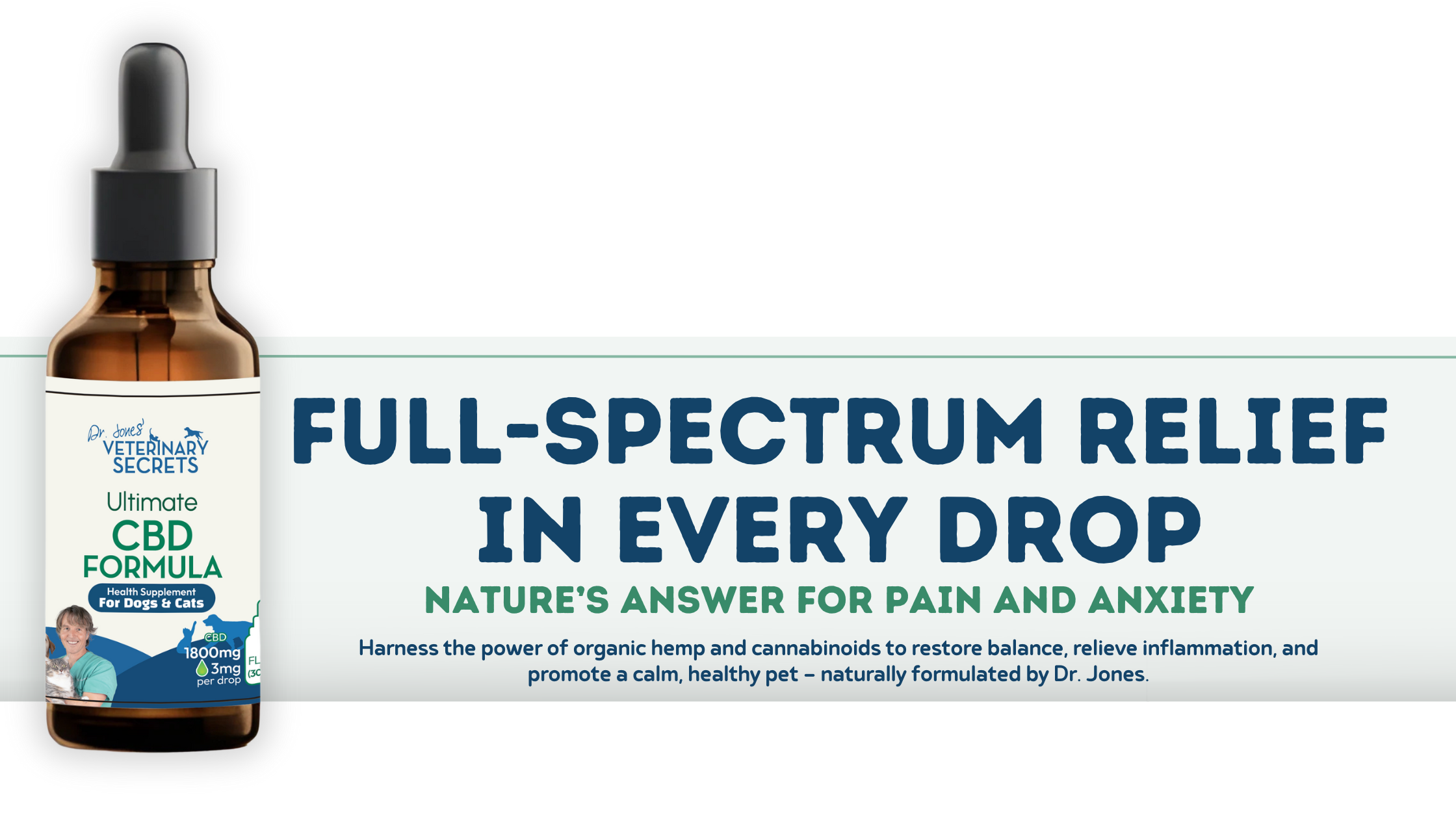
Melatonin
Melatonin is known as a sleep hormone, but it also plays a role in hair growth and regrowth.
Benefits for overgrooming cats:
-
Mild anti anxiety effect
-
Encourages normal hair growth cycles
-
Acts as an antioxidant
Typical dose: 1 to 2 mg per cat, about an hour before bedtime.
Catnip
Do not forget the simple things.
Catnip can:
-
Trigger playful behavior
-
Release happy brain chemicals
-
Help a stressed indoor cat feel better
Use it a couple of times a day if your cat enjoys it.
Reason 4: Urinary Tract Disease
This is one many people do not think about. Cats with urinary tract inflammation or cystitis will often overgroom their lower belly or genital area.
You may see:
-
Licking over the bladder area
-
Grooming the penis in male cats
-
Straining to urinate
-
Frequent trips to the litter box
-
Blood in the urine
If your cat is overgrooming in that lower belly region, especially along with straining to urinate, you need to take this seriously.
Very Important
If your cat:
-
Is straining to urinate
-
Produces little or no urine
-
Seems painful in the litter box
Do not start with home remedies.
You need to go in immediately to rule out a urinary obstruction. That is a true emergency.
Natural Support For Urinary Tract Inflammation
Once obstruction is ruled out, natural remedies can help with stress and bladder wall inflammation.
I have seen many cats with urinary tract disease improve with:
CBD Again
CBD can:
-
Lower anxiety
-
Decrease bladder inflammation
-
Help break the stress–cystitis cycle
Typical dose: 3 mg per 10 pounds of body weight, twice daily.
Glucosamine And Chondroitin
These are not just for joints. They can help repair and rebuild the bladder lining as well.
A good feline supplement with glucosamine and chondroitin, such as Dr. Jones’ Ultimate Feline Health Formula, can support long term bladder health.
Dr. Jones’ Ultimate Feline Health Formula

Canned Food And Moisture
This is critical.
Cats like Cassian do best on canned food or other moisture rich diets, not dry kibble.
More moisture means:
-
Better bladder flushing
-
Less crystal formation
-
Less pain as the bladder fills and empties
Simply increasing moisture often leads to a big improvement in urinary health.
Reason 5: Arthritis And Joint Pain
Another overlooked cause of overgrooming is joint pain or arthritis, especially in older cats.
If your cat is licking or chewing:
-
Over the wrists (carpus)
-
Over the hocks (tarsus)
-
Over the knees
-
Around specific joints
Then arthritis could be involved.
In practice, I would often see:
-
Local patches of hair loss over a sore joint
-
Cats licking the same area repeatedly
Natural Help For Arthritic Cats
Since cats do not tolerate NSAIDs safely long term, I rely more on joint support and natural pain control.
Helpful options include:
-
CBD
-
3 mg per 10 pounds, twice daily
-
-
Glucosamine, chondroitin and MSM
-
For joint repair and lubrication
-
Included in Dr. Jones’ Ultimate Feline Health Formula
-
-
Essential fatty acids (fish oil or krill oil)
-
To reduce inflammation in the joints
-
Often, a combination of joint support plus omega 3s can make a big difference.
If the overgrooming is linked to arthritis pain, addressing the pain often resolves the excessive licking.
Step By Step: How To Help A Cat That Overgrooms
If your cat is overgrooming, do not panic. Work through these steps:
-
Check for fleas and parasites
-
Use a flea comb
-
Consider food grade diatomaceous earth
-
-
Think allergies
-
Eliminate fish and dairy
-
Add omega 3 fatty acids
-
Consider quercetin for itch relief
-
-
Address stress and anxiety
-
Enrich the environment
-
Try L theanine, valerian, CBD, melatonin or catnip
-
-
Watch for urinary signs
-
Belly overgrooming plus straining means vet check
-
Support bladder health with CBD, glucosamine and canned food
-
-
Consider joint pain in older cats
-
Look for licking over specific joints
-
Use CBD, joint supplements and omega 3s
-
With some observation, simple tests at home and the right natural remedies, you can often figure out why your cat is overgrooming and help them feel more comfortable.
Thank you for reading this edition of Veterinary Secrets on why your cat is overgrooming and what you can do at home to help.
Click To Get A Free Copy of My E-Book!

Stay Connected with Dr. Andrew Jones DVM:
- Visit our website: https://veterinarysecrets.com/
- Subscribe for more pet care tips: https://www.youtube.com/@VeterinarySecrets
- Facebook: http://facebook.com/veterinarysecrets
- Instagram: http://instagram.com/veterinarysecrets
- Twitter: http://twitter.com/dogandcatdoc
- Pinterest: http://pinterest.com/veterinarysecrets
- Podcast: http://vetsecrets.podbean.com/



